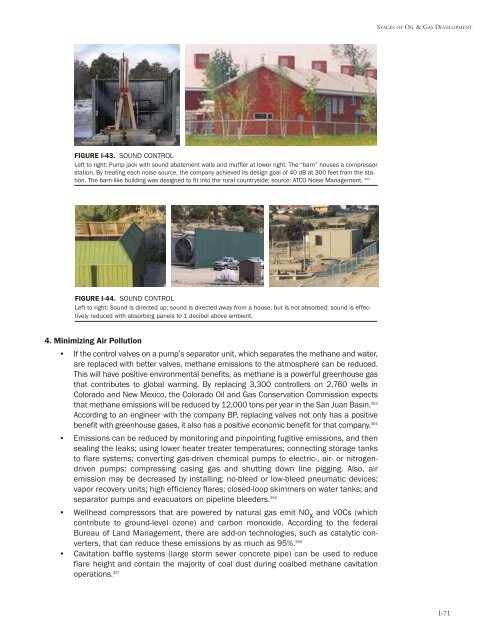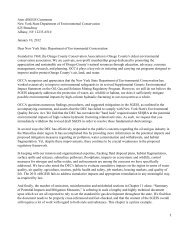Oil and Gas at Your Door? (2005 Edition) - Earthworks
Oil and Gas at Your Door? (2005 Edition) - Earthworks
Oil and Gas at Your Door? (2005 Edition) - Earthworks
Create successful ePaper yourself
Turn your PDF publications into a flip-book with our unique Google optimized e-Paper software.
STAGES OF OIL & GAS DEVELOPMENT<br />
FIGURE I-43. SOUND CONTROL<br />
Left to right: Pump jack with sound ab<strong>at</strong>ement walls <strong>and</strong> muffler <strong>at</strong> lower right. The “barn” houses a compressor<br />
st<strong>at</strong>ion. By tre<strong>at</strong>ing each noise source, the company achieved its design goal of 40 dB <strong>at</strong> 300 feet from the st<strong>at</strong>ion.<br />
The barn-like building was designed to fit into the rural countryside; source: ATCO Noise Management. 352<br />
FIGURE I-44. SOUND CONTROL<br />
Left to right: Sound is directed up; sound is directed away from a house, but is not absorbed; sound is effectively<br />
reduced with absorbing panels to 1 decibel above ambient.<br />
4. Minimizing Air Pollution<br />
• If the control valves on a pump’s separ<strong>at</strong>or unit, which separ<strong>at</strong>es the methane <strong>and</strong> w<strong>at</strong>er,<br />
are replaced with better valves, methane emissions to the <strong>at</strong>mosphere can be reduced.<br />
This will have positive environmental benefits, as methane is a powerful greenhouse gas<br />
th<strong>at</strong> contributes to global warming. By replacing 3,300 controllers on 2,760 wells in<br />
Colorado <strong>and</strong> New Mexico, the Colorado <strong>Oil</strong> <strong>and</strong> <strong>Gas</strong> Conserv<strong>at</strong>ion Commission expects<br />
th<strong>at</strong> methane emissions will be reduced by 12,000 tons per year in the San Juan Basin. 353<br />
According to an engineer with the company BP, replacing valves not only has a positive<br />
benefit with greenhouse gases, it also has a positive economic benefit for th<strong>at</strong> company. 354<br />
• Emissions can be reduced by monitoring <strong>and</strong> pinpointing fugitive emissions, <strong>and</strong> then<br />
sealing the leaks; using lower he<strong>at</strong>er tre<strong>at</strong>er temper<strong>at</strong>ures; connecting storage tanks<br />
to flare systems; converting gas-driven chemical pumps to electric-, air- or nitrogendriven<br />
pumps; compressing casing gas <strong>and</strong> shutting down line pigging. Also, air<br />
emission may be decreased by installing: no-bleed or low-bleed pneum<strong>at</strong>ic devices;<br />
vapor recovery units; high efficiency flares; closed-loop skimmers on w<strong>at</strong>er tanks; <strong>and</strong><br />
separ<strong>at</strong>or pumps <strong>and</strong> evacu<strong>at</strong>ors on pipeline bleeders. 355<br />
• Wellhead compressors th<strong>at</strong> are powered by n<strong>at</strong>ural gas emit NO x <strong>and</strong> VOCs (which<br />
contribute to ground-level ozone) <strong>and</strong> carbon monoxide. According to the federal<br />
Bureau of L<strong>and</strong> Management, there are add-on technologies, such as c<strong>at</strong>alytic converters,<br />
th<strong>at</strong> can reduce these emissions by as much as 95%. 356<br />
• Cavit<strong>at</strong>ion baffle systems (large storm sewer concrete pipe) can be used to reduce<br />
flare height <strong>and</strong> contain the majority of coal dust during coalbed methane cavit<strong>at</strong>ion<br />
oper<strong>at</strong>ions. 357 I-71




